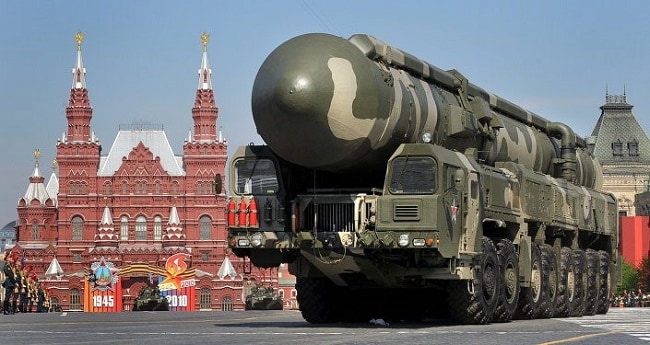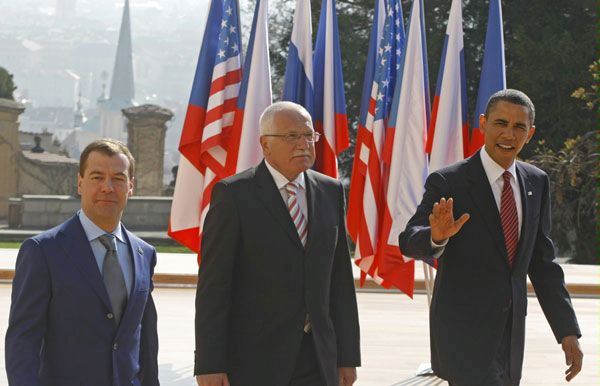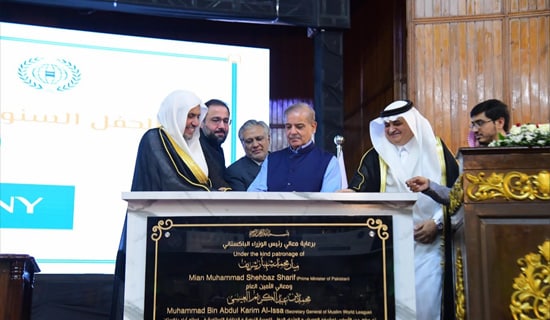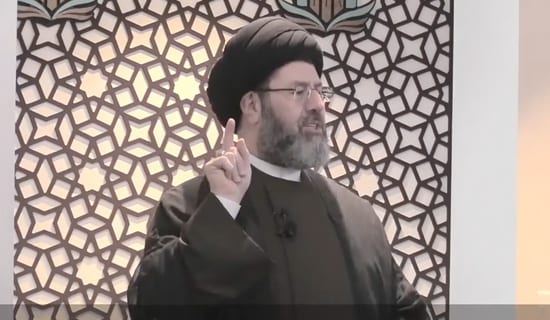On April 26, 2016, the Russian newspaper Nezavisimaya Gazeta published an article, titled "Russia and the Arms Race", by Alexei Georgievich Arbatov, head of the Center for International Security at the Institute of World Economy and International Relations (IMEMO), member of the Russian Academy of Science and member of the Presidium of the Council for Foreign and Defense Policy.[1] Arbatov writes that despite statements by Russian officials that Russia won't be dragged into an arms race, the reality is that Russia is engaged in a large-scale military rivalry with the U.S. and NATO countries.[2] According to Arbatov, the new arms race will be more costly and more dangerous than the Cold War version. Arbatov argues that the difference between the current arms race and the Cold War's competition is that hitherto, the race was limited by a series of treaties, whereas in the future all "limitations may be cast aside." He also suggests that nuclear disarmament and non-proliferation systems may collapse and the "the probability of military, accidental or terrorist use of nuclear arms" is high.
Following are excerpts from Arbatov's article:

RS-12M ICBM
TOPOL (NATO designation
SS-25 Sickle) during a military parade in Moscow's Red Square .
(Source: Sputniknews.com)
"The New Arms Race May Prove To Be More Complex, Costly And Dangerous Than The One During The Cold War"
"Despite occasional official statements that Russia will not be dragged into an arms race, the real situation is different. [Russia] is already being drawn into a large-scale military rivalry, mostly with the U.S., and the new arms race may prove to be more complex, costly and dangerous than the one during the Cold War. At the moment, one can detect at least four directions that this process is taking. In this case we are talking notably only about strategic arms, leaving general-purpose forces aside. Their technical re-equipment according to [Russia's] State Armaments Programs [SAP] for 2020 and 2025 also has a clear competitive aspect vis-à-vis the aviation, land forces, and fleet of the NATO countries.
"Firstly, developments in the sphere of offensive Strategic Nuclear Forces (SNF) are proceeding at full speed. SAP-2020 stipulates the deployment by 2020 of 400 new intercontinental ballistic missiles, 8 nuclear-powered ballistic missile submarines, the creation of a new generation of heavy bombers (PAK-DA) with air launched long-range dual mission cruise missile X-101/102, and prior to that - re-launching the manufacture of the modernized Tu-160 bombers. These systems are intended to replace outdated equipment being withdrawn from operational use; i. e. they are aimed at renewing Russian strategic forces under the New START Treaty of 2010.[3]
"The U.S., in accordance with the life cycle of its strategic systems, will start their renovation after 2020; during the first decade of the process, 350 billion dollars will be allocated to it, whereas the sum for the 30 years of the complete refurbishment of the nuclear triad is approximately 1 trillion dollars. Of course, the U.S. program will have as its aim standoff [capability] against the currently deployed systems of Russia (and China). It is quite possible that Russia, in its turn, will be compelled to react to this in its further development of SNF. Thus, the classical offensive nuclear arms race will start in only a few years. A buildup of land-based intermediate-range missiles may be added to it, if the Intermediate-Range Nuclear Forces (INF) Treaty of 1987 is denounced, which is a measure advocated by several Russian experts and even senior state officials deem it possible.[4]

U.S.
President Ronald Reagan and Soviet leader Mikhail Gorbachev exchange pens
during the Intermediate Range Nuclear Forces Treaty signing ceremony in the
White House East Room in Washington, D.C. on December 8, 1987. Gorbachev's
translator Pavel Palazhchenko stands in the middle. (Source: Wladamosci.gazeta.pl)
"The Entire Nuclear Disarmament And Non-Proliferation System May Collapse"
"All this is more or less familiar: during the Cold War, this was the direction that the rivalry between the two superpowers took. The only difference is that in the past, after 1972, this race was limited by a series of treaties - SALT/INF/START/SORT, whereas in the future all such limitations may be cast aside. Since the START Treaty was concluded in 2010, for the past six years, no negotiations have taken place, due to both political reasons and the parties' inability to overcome their differences on missile defense and other issues. Earlier, new negotiations started immediately after the conclusion of yet another treaty, and both parties approached them with their agenda prepared in advance. Now, the two powers take different attitudes towards nuclear weapons in general - in a sense, they have exchanged places in comparison with the last decade (after 2000).

U.S.
President Barack Obama, right, waves next to Czech President Vaclav Klaus,
center, and then Russian President Dmitry Medvedev before the signing of the
New START treaty in Prague, Thursday, April 8, 2010. (Source: State.gov)
"There is less and less time for negotiations on a new treaty, and it appears that this fact does not bother the Russian political elite at all. Thus, following the expiration of the current START Treaty in 2020, a gaping hole may appear in the vital sphere of nuclear weapons control for the first time in 45 years. As a result, the entire nuclear disarmament and non-proliferation system may collapse - a system created over the last half-century by the tireless efforts of state leaders, diplomats, politicians, and the military and civilian experts of the leading world powers.
SUPPORT OUR WORK

"But this is notthe entire story. Even now, long before 2020, the second channel of the arms race has been opened: Russian offensive nuclear arms vs. the American missile defense system. This channel did not exist in the Cold War, because nobody had such defense systems before 1972, and they were strictly regulated after 1972 by the Anti-Ballistic Missile Treaty (ABMT) that the U.S. withdrew from in 2002. New Russian offensive nuclear arms and dual purpose systems (including operational-tactical systems) have been created not only to renovate Russia's strike potential; they have the additional goal of serving as a means for overcoming the missile defense systems of the U.S. and its allies."
"The Cooperation Between Russia And the U.S. About Increasing The Safety And Security Of Nuclear Materials And Facilities Has Ceased"
"The third channel of the arms race - the most innovative - is offensive high-precision long-range conventionally armed systems, including existing subsonic (cruise) missiles and future hypersonic missiles. It is probable that [Russian] president [Vladimir] Putin had these systems in mind when he noted in his 2012 article [outlining his policies prior to the presidential elections] : 'All this will provide fundamentally new instruments for achieving political and strategic goals in addition to nuclear weapons. Such weapon systems will be as effective as nuclear weapons but will be more acceptable from the political and military point of view. Therefore, the strategic balance of nuclear forces will gradually lose its significance in the matter of deterring aggression and chaos.'
"Russia's goal is to catch up with the U.S. as soon as possible in the matter of such systems. This channel of the arms race may prove to be extremely costly, since the newest strike power mandates creating perfect information and control systems, including space-based ones. And such systems will, in their turn, offer an inducement for development of countermeasures: anti-satellite, radio-electronic, and cybernetic ones.
"Finally, the fourth channel is Russian Aerospace Defense vs. the American means of air and space attack. In June 2013, during a visit to an air defense missile manufacturing plant, president Putin said: 'Effective aerospace defense is a guarantee of our strategic deterrent forces' survivability, and the country's protection from aerospace strike threats.' It is still unclear, however, what weapon systems exactly fit this category, but one may conclude that it is primarily high-precision conventionally armed systems, both subsonic and hypersonic. Moreover, as often happened in the past, in the competition between strategic defense and attack, it is defense that sustains much heavier costs.
"Such a multi-channel race of strategic offensive and defensive, nuclear and non-nuclear, weapons did not exist in the Cold War years. The current situation is aggravated by the economic inequality of the parties, especially in the context of the financial and economic crisis in Russia. Besides, Russia, as opposed to the U.S., cannot count on any significant help from its allies and partners.
Another important difference from the past is that the new arms race will not only be multi-channel, but also multilateral. Offensive nuclear weapons are being intensively built up in China, Pakistan, India and North Korea, they are maintained and upgraded by Great Britain, France, and Israel. In addition, China develops hypersonic high-precision non-nuclear systems, and in this [field] it leads Russia and the U.S. Unlike the Cold War era, the arms race will take place in at least two trilateral formations: Russia-U.S.-China and China-India-Pakistan. Moreover, if previously missile defense systems were the monopoly of the USSR and U.S., in the future they will be developed, separately or collectively, by the NATO countries, China, India, Israel, Japan and South Korea.
"With all this as the background, the nuclear non-proliferation regime will inevitably collapse; and the failure of the 2015 Review Conference of the Parties to the Treaty on the Non-Proliferation of Nuclear Weapons (NPT) attests to this fact.[5] The treaty is almost 50 years old, it was created for another world and has a lot of gaps, primarily in what concerns the distinction between peaceful and military uses of nuclear power. The 2015 agreement with Iran could have become a step towards resolving this issue, but that agreement states directly that all its conditions pertain exclusively to Iran and cannot furnish a precedent for other similar cases. The NPT gaps are not patched, because no agreement between the great powers about it exists. What is worse, the cooperation between Russia and the U.S. about increasing the safety and security of nuclear materials and facilities has ceased, and Russia even refused to attend the latest nuclear security summit in spring 2016.[6]
"The Development Of The Nuclear Power Industry Will Make A Huge Leap In The Next 20 Years"
"Meanwhile, the development of the nuclear power industry will make a huge leap in the next 20 years. At the moment, there are 435 nuclear reactors in the world, 65 more are under construction, and 167 are in the planning stage, including those in the most unstable regions of the world: the Middle EastSouth-East Asia, Africa and Latin America. This means that the proliferation of nuclear technologies and materials will erupt with the ever growing probability that they will fall into the hands of terrorist organizations that are hunting for a nuclear warhead, an explosive device or at least some radioactive material for a 'dirty bomb'.
"Finally, new problems have appeared, such as threats of cyber attacks, which may, inter alia, be directed against information and control systems of nuclear forces.
" This entire array of issues should be central for ensuring international security, but it is not -it is on the margins of world politics. Without negotiations and regular contacts between military and civilian state representatives, the views of Russia, the U.S. and a number of other states on the rules and limits of nuclear deterrence, the role of nuclear weapons, scenarios and methods of their use are becoming increasingly divergent, which may lead to a fateful miscalculation or incident. Therefore, the paradox of the current situation is that over the past quarter of a century, the quantity of nuclear weapons has declined by a factor of five or seven thanks to treaties and unilateral reductions, but the probability of their use has grown considerably. If no urgent measures are taken to strengthen the regime of reduction, limitation and non-proliferation of nuclear weapons, then, in the light of new threats and challenges, the probability of military, accidental or terrorist use of nuclear arms will continue to grow with catastrophic consequences for modern civilization.
"Strengthening the system of control over nuclear arms in the foreseeable future will require multinational efforts, but without the initiative of Russia and the U.S. the process will not get off the ground. These two powers still possess up to 90% of nuclear weapons and materials on the planet. The first urgent steps must be finding a solution for the clashes of opinion and preserving the validity of the INF Treaty, as well as starting negotiations on a new START agreement for the period after 2020. This will provide momentum to other channels of reduction and non-proliferation of nuclear weapons and materials, and involve other nuclear states in the process.
"All the existing world problems, including migration, climate, economic crises, ethnic and religious conflicts, can be solved sooner or later, one way or another, if we manage to prevent a nuclear catastrophe. If not - there will be nobody to deal with those problems."
Endnotes:
[1] Ng.ru, April 26, 2016.
[2] See MEMRI Special Dispatch No. 6433, Official Russian Campaign Against NATO's Ballistic Missile Defense System in Europe - Part I, May 16, 2016. See also MEMRI Special Dispatch No. 6434, Official Russian Campaign Against NATO's Ballistic Missile Defense System In Europe - Part II, May 17, 2016.
[3] See New START Treaty: Treaty Between The U.S. And the Russian Federation On Measures For The Further Reductions And Limitation Of Strategic Offensive Arms.
[4] See INF Treaty: Treaty Between The U.S. And The Union Of Soviet Republics On The Elimination Of Their Intermediate-Range And Shorter-Range Missiles
[5] See 2015 Review Conference Of the Parties To The Treaty On The Non-Proliferation Of Nuclear Weapons (NPT), April 27 - May 22, 2015.
[6] See MEMRI Special Dispatch No. 6369, Russia Boycotts U.S.-Hosted Nuclear Summit, April 1, 2016.




